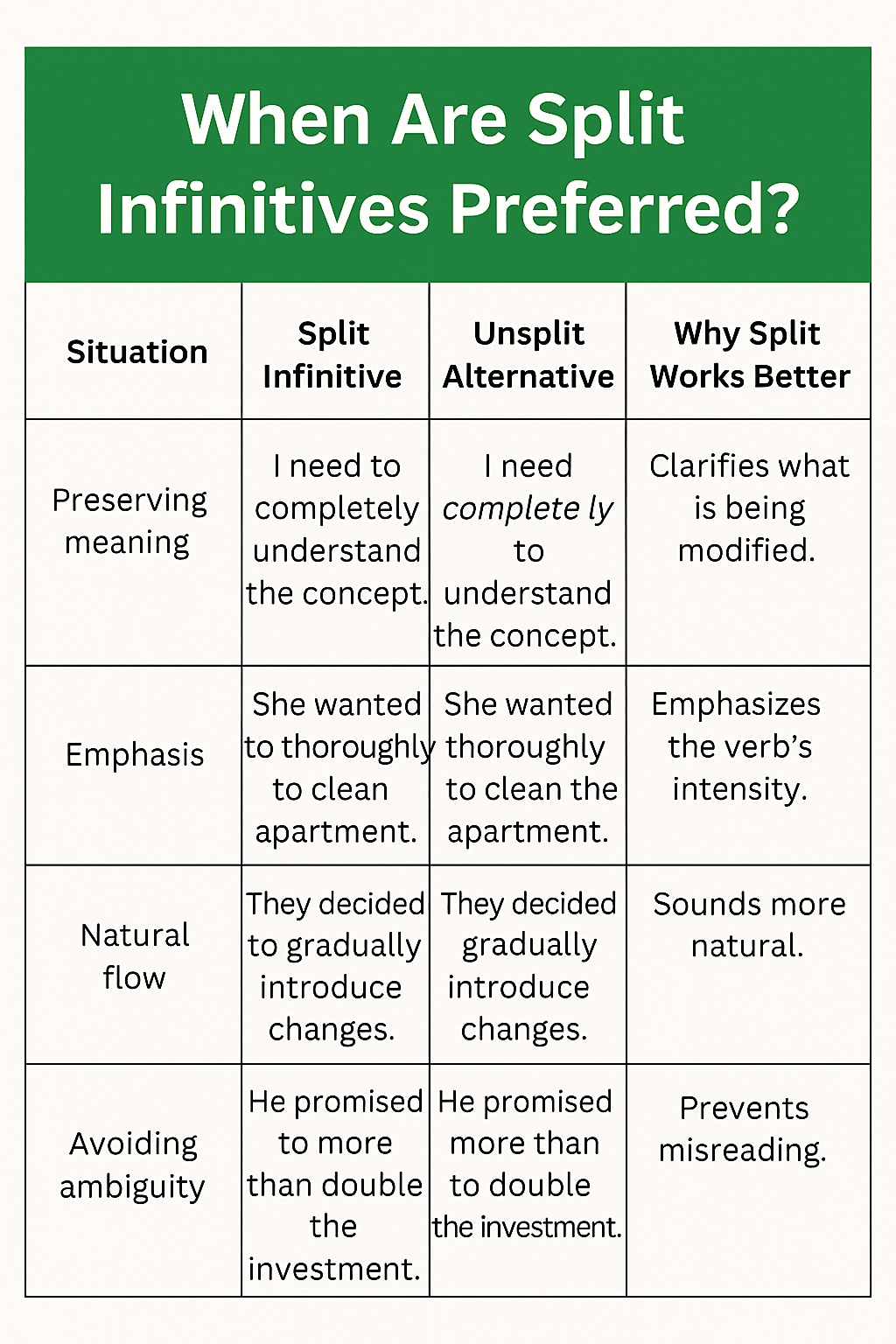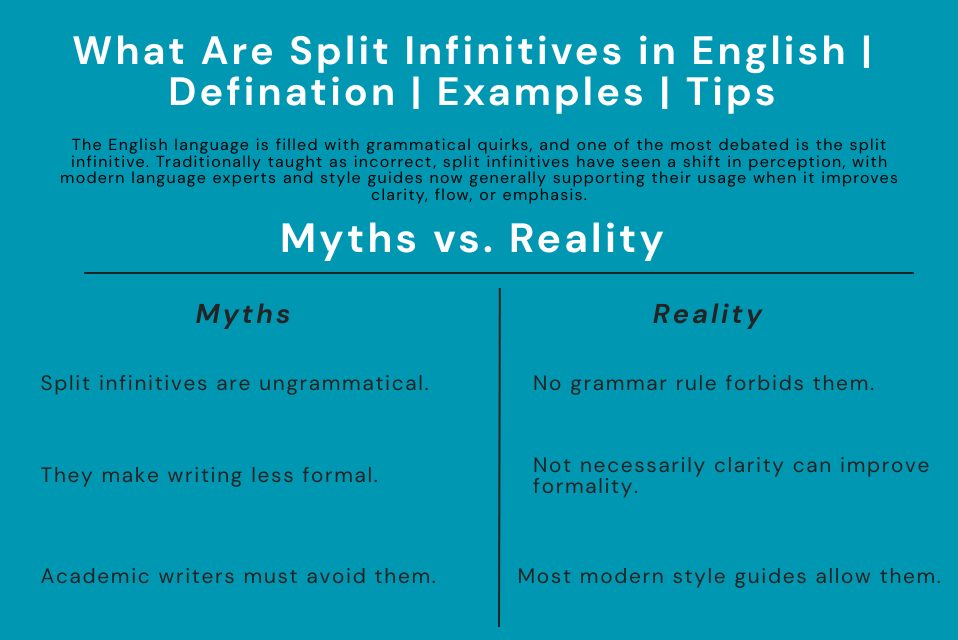The English language is filled with grammatical quirks, and one of the most debated is the split infinitive. Traditionally taught as incorrect, split infinitives have seen a shift in perception, with modern language experts and style guides now generally supporting their usage when it improves clarity, flow, or emphasis. If you’re navigating grammar rule debates and want to avoid common pitfalls, take a look at some of the top grammar mistakes learners make.
What Is a Split Infinitive?
An infinitive is the base form of a verb, typically preceded by the word “to” (e.g., to walk, to understand). A split infinitive occurs when an adverb or phrase is inserted between “to” and the verb.
Examples:
- To boldly go where no one has gone before.
- She decided to carefully review the document.
- He wanted to better understand the concept.
Historical Perspective
The rule against split infinitives originated in the 19th century when grammarians sought to model English grammar on Latin where infinitives cannot be split due to their single-word structure. This artificial rule persisted throughout the Victorian era, despite being inconsistent with natural English usage.
Key Point:
Split infinitives have been used by English writers including Chaucer and Shakespeare long before prescriptive rules opposed them.
The Modern View
Leading authorities such as the Chicago Manual of Style, Oxford English Dictionary, and Associated Press Stylebook now accept split infinitives, particularly when they enhance clarity or readability.
Citation: Chicago Manual of Style, 17th ed., Section 5.106 confirms the acceptability of split infinitives for clarity.
When Are Split Infinitives Preferred?

| Situation | Split Infinitive | Unsplit Alternative | Why Split Works Better |
| Preserving meaning | I need to completely understand the concept. | I need completely to understand the concept. | Clarifies what is being modified. |
| Emphasis | She wanted to thoroughly clean the apartment. | She wanted thoroughly to clean the apartment. | Emphasizes the verb’s intensity. |
| Natural flow | They decided to gradually introduce changes. | They decided gradually to introduce changes. | Sounds more natural. |
| Avoiding ambiguity | He promised to more than double the investment. | He promised more than to double the investment. | Prevents misreading. |
Common Patterns of Split Infinitives
- Single adverb: to fully appreciate, to quickly respond
- Multiple words: to not only understand but also appreciate, to almost completely eliminate
When to Avoid Split Infinitives
1. Formal Academic Writing: In conservative academic circles, it may still be safer to avoid them.
2. Awkward Constructions: Some splits sound clunky.
- Less Natural: We need to quickly run to the store.
- Better: We need to run to the store quickly.
3. When Clarity Isn’t Improved:
| Split | Unsplit | Note |
| I want to clearly explain the process. | I want to explain the process clearly. | Both are clear—either is fine. |
Writing Contexts
- Creative Writing: Freely use split infinitives for style and rhythm.
- Business & Professional: Prioritize clarity; split when it improves understanding.
- Journalism: Accepted by most guides, including AP and Reuters.
- Academic Writing: Increasingly accepted, but varies by discipline.
Myths vs. Reality
| Myth | Reality |
| Split infinitives are ungrammatical. | No grammar rule forbids them. |
| They make writing less formal. | Not necessarily clarity can improve formality. |
| Academic writers must avoid them. | Most modern style guides allow them. |
Practical Guidelines
Prioritize clarity and flow.
- She expected to almost double her income → better than “expected almost to double.”
Know your audience.
- General readers are unlikely to object. Editors might.
Test alternatives.
- To seriously consider the proposal → vs. “To consider the proposal seriously”
Be consistent.
- In formal writing, maintain a uniform approach.
Examples by Genre
- Literary: “To thoroughly investigate every lead”
- Academic: “This paper aims to critically analyze…”
- Business: “We strive to consistently deliver results.”
- Journalism: “The senator decided to publicly address the controversy.”
Historical Evolution Summary
| Era | Attitude | Example |
| Middle English | Freely used | Chaucer’s texts |
| 18th–19th c. | Prescriptive | Grammar manuals impose rules |
| Victorian | Strong prohibition | Schools ban split forms |
| 20th c. | Gradual shift | Debate resurfaces |
| Modern | Broad acceptance | “To boldly go…” |
Conclusion
Split infinitives are now widely accepted when used to improve clarity, flow, or emphasis. Avoiding them purely for tradition’s sake may do more harm than good. Writers should feel empowered to use them strategically and thoughtfully.
Frequently Asked Questions (FAQs)
Q: What is a split infinitive example?
“To boldly go where no one has gone before.”
Q: Are split infinitives grammatically wrong?
No. They’re stylistic choices, not errors.
Q: When should I avoid them?
In overly formal writing or if they sound awkward.







